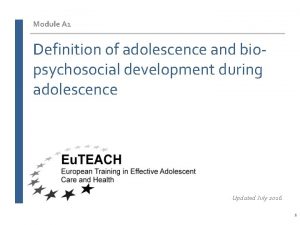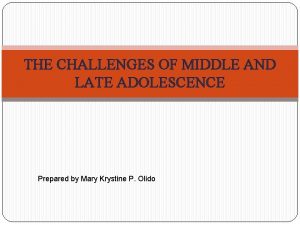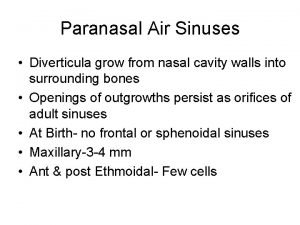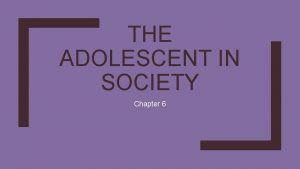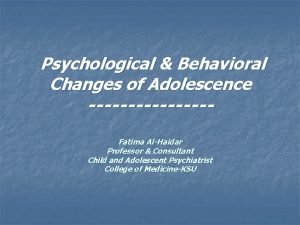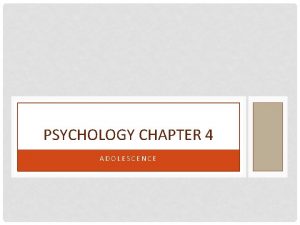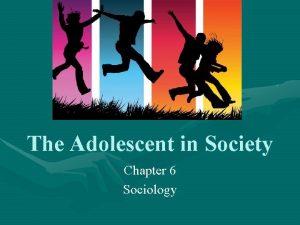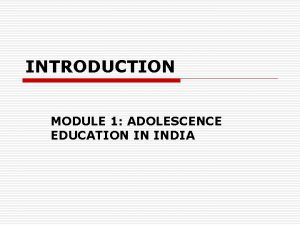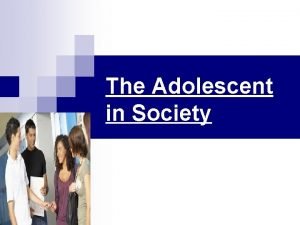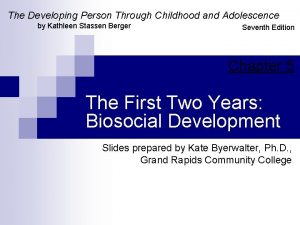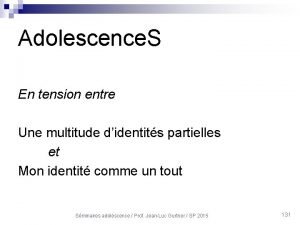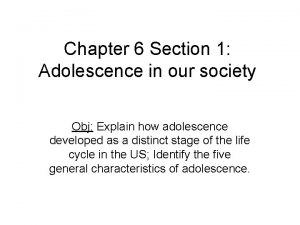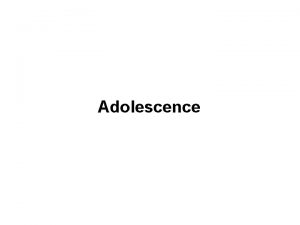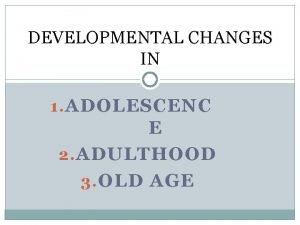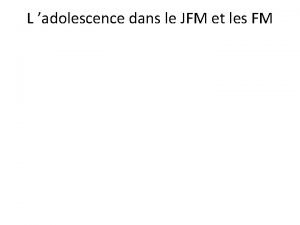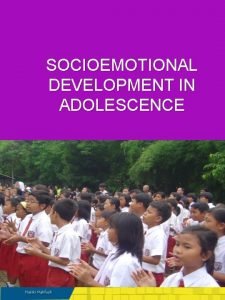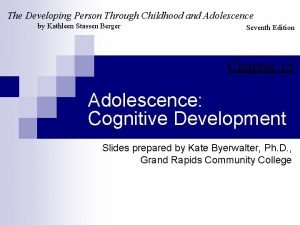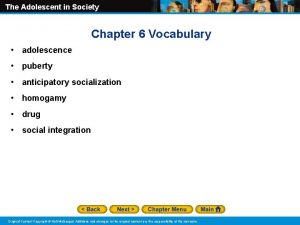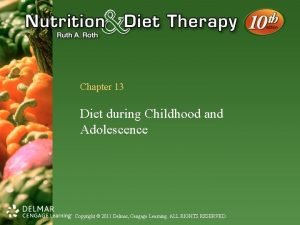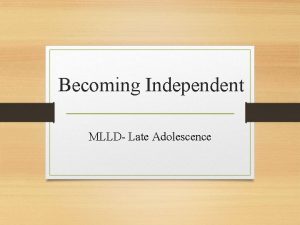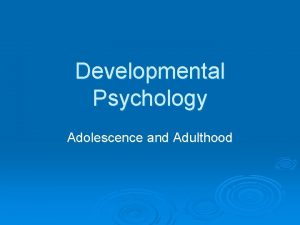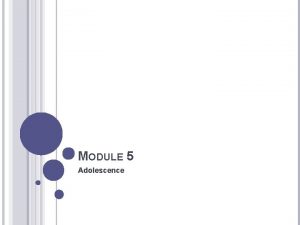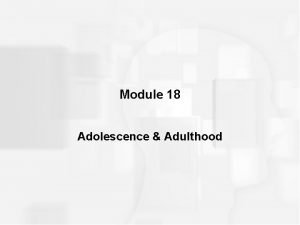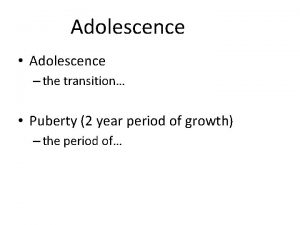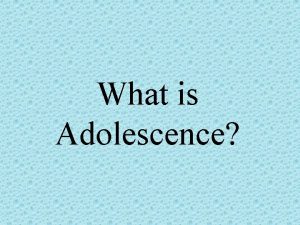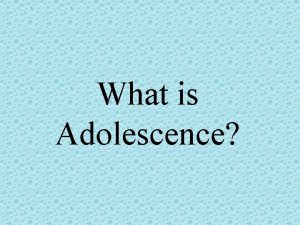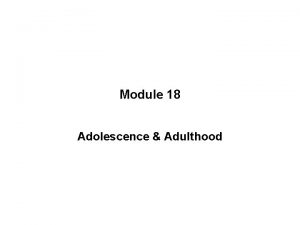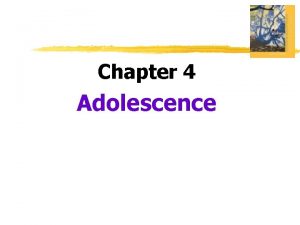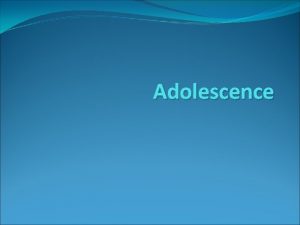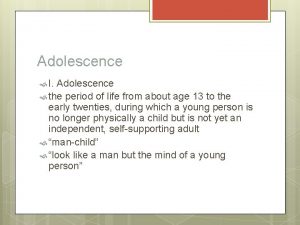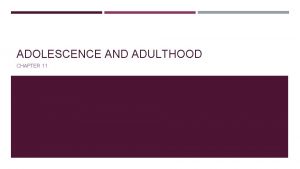Adolescence Period that was once considered late adolescence




















































- Slides: 52


Adolescence • Period that was once considered late adolescence (from age 18 to adulthood) • Now considered a separate period called emerging adulthood

Puberty Begins

Puberty • Time between the first onrush of hormones and full adult physical development • Usually lasting three to five years • Requires many more years are required to achieve psychosocial maturity

Puberty Menarche • Girl's first menstrual period, signaling that she has begun ovulation. • Pregnancy is biologically possible, but ovulation and menstruation are often irregular for years after menarche. Spermarche • Boy's first ejaculation of sperm. • Erections can occur as early as infancy, but ejaculation signals sperm production.

Puberty: Unseen Beginnings Hormone • Organic chemical substance that is produced by one body tissue and conveyed via the bloodstream to another to affect some physiological function. • Various hormones influence thoughts, urges, emotions, and behavior.

Puberty: Unseen Beginnings Pituitary gland • Gland in the brain that responds to a signal from the hypothalamus by producing many hormones, including those that regulate growth and control other glands, among them the adrenal and sex glands.

Biological Sequence of Puberty begins with a hormonal signal from the hypothalamus to the pituitary gland. The pituitary, in turn, signals the adrenal glands and the ovaries or testes to produce more of their hormones.

Puberty: Unseen Beginnings Adrenal glands • Two glands, located above the kidneys, that produce hormones (including the “stress hormones” epinephrine [adrenaline] and norepinephrine).

Puberty: Unseen Beginnings HPA (hypothalamus–pituitary–adrenal) axis • Sequence of a chain reaction of hormone production, originating in the hypothalamus and moving to the pituitary and then to the adrenal glands.

Puberty: Unseen Beginnings HPA (hypothalamus–pituitary–adrenal) axis • Sequence of a chain reaction of hormone production, originating in the hypothalamus and moving to the pituitary and then to the adrenal glands. HPG (hypothalamus–pituitary–gonad) axis • Sequence of hormone production that originates in the hypothalamus, moves to the pituitary, and then to the gonads.

Puberty Begins Gonads • Paired sex glands (ovaries in females, testicles in males). • Gonads produce hormones and gametes. Estradiol • Sex hormone, considered the chief estrogen. • Females produce more estradiol than males do. Testosterone • Sex hormone, the best known of the androgens (male hormones). Secreted in far greater amounts by males than by females.

Puberty Begins Circadian rhythm • Day–night cycle of biological activity occurs approximately every 24 hours (circadian means “about a day”). • Hormones of the HPA axis at puberty cause a phase delay in sleep–wake cycles. • Biology (circadian rhythms) and culture (parties and technology) work to make teenagers increasingly sleepdeprived with each year of high school.

Dreaming and Learning? This graph shows of U. S. students who, once a week or more, fall asleep in class or are too tired to exercise. Not shown are those who are too tired overall (59 percent for high school students) or who doze in class “almost every day” (8 percent).

Puberty Begins Influences on the Age of Puberty • Age 11 or 12 is the most likely age of visible onset. • The rise in hormone levels that signals puberty is still considered normal in those as young as age 8 or as old as age 14. • Precocious puberty (sexual development before age 8) occurs about once in 5, 000 children, for unknown reasons.

Earliest and Latest

Earliest and Latest

Puberty Begins • About two-thirds of the variation in age of puberty is genetic. • Genes on the sex chromosomes have a marked effect on age of puberty. • Girls generally develop ahead of boys. • Children who have a relatively large proportion of body fat experience puberty sooner than do their thin contemporaries.

Puberty: Body Fat Leptin • Hormone affects appetite and is believed to be involved in the onset of puberty. • Leptin levels increase during childhood and peak at around age 12. • In both sexes, chronic malnutrition delays puberty.

Puberty Begins Secular trend • Data on puberty over the centuries that reveals a dramatic example of a long-term statistical increase or decrease. • Each generation has experienced puberty a few weeks earlier, and has grown a centimeter or so taller, than did the preceding one. • Secular trend has stopped in developed nations.

Puberty Begins Too early, too late • Early-maturing girls tend to have lower self-esteem, more depression, and poorer body image than later-maturing girls. • Early-maturing boys are more aggressive, law-breaking, and alcohol-abusing than later-maturing boys. • Slow developing boys tend to be more anxious, depressed, and afraid of sex.

Growing Bigger and Stronger Growth spurt • Spurt is a relatively sudden and rapid physical growth that occurs during puberty. • Each body part increases in size on a schedule. • Height spurt follows the increase in body fat, and then a muscle spurt occurs.

Growing Bigger and Stronger Growth spurt • Lungs triple in weight; consequently, adolescents breathe more deeply and slowly. • Heart doubles in size and the heartbeat slows, decreasing the pulse rate while increasing blood pressure. • Only lymphoid system (which includes the tonsils and adenoids), decreases in size--teenagers are less susceptible to respiratory ailments.

Growing Bigger and Stronger Skin and hair • Skin becomes oilier, sweatier, and more prone to acne. • Hair on the head and limbs becomes coarser and darker. • New hair grows under arms, on faces, and over sex organs. • In many ways, hair is more than a growth characteristic; it becomes a display of sexuality.

Sexual Maturation Primary sex characteristics • Parts of the body that are directly involved in reproduction, including the vagina, uterus, ovaries, testicles, and penis. Secondary sex characteristics • Physical traits that are not directly involved in reproduction but that indicate sexual maturity, such as a man's beard and a woman's breasts.

Puberty Begins Nutrition • Many adolescents are deficient in their intake of necessary vitamins or minerals. • Deficiencies of iron, calcium, zinc, and other minerals, since these are needed for bone and muscle growth. • Nutritional deficiencies result from the food choices that young adolescents are allowed, even enticed, to make.

Puberty Begins Body image • Person's idea of how his or her body looks. • Girls diet partly because boys tend to prefer to date thin girls. • Boys want to look taller and stronger partly because girls value well-developed muscles in males.

Puberty Begins Eating disorders • Anorexia nervosa – Eating disorder characterized by severe calorie restriction and the fear of being fat. – Affected individuals voluntarily undereat, or overeat and then overexercise or purge, depriving their vital organs of nutrition. – Anorexia can be fatal.

Puberty Begins Eating disorders • Bulimia nervosa – Eating disorder characterized by binge eating and subsequent purging, usually by induced vomiting and/or use of laxatives.

Neurological Development Different parts of the brain grow at different rates. • Limbic system (fear, emotional impulses) matures before the prefrontal cortex (planning ahead, emotional regulation). • Instinctual and emotional areas develop before the reflective ones do.

Same People, But Not the Same Brain

Cognitive Development Logic shut down • When emotions are intense, especially when one is with peers, the logical part of the brain shuts down. • When stress, arousal, passion, sensory bombardment, drug intoxication, or deprivation is extreme, the adolescent brain is overtaken by impulses that might shame adults.

Cognitive Development Positive aspects of adolescent brain development • Increased mylenation, which decreases reaction time • Enhanced dopamine activity, promoting pleasurable experiences • Synaptic growth, enhancing moral development and openness to new experiences and ideas

Cognitive Development Risk and reward • Neurological research finds that the reward parts of adolescents’ brains are far stronger than inhibition parts. • Slower-maturing prefrontal cortex makes powerful sensations desirable—loud music, speeding cars, strong drugs—compelling.

Thinking About Oneself Adolescent egocentrism • Characteristic of adolescent thinking that leads young people (ages 10 to 14) to focus on themselves to the exclusion of others. Personal fable • Aspect of adolescent egocentrism characterized by an adolescent's belief that his or her thoughts, feelings, or experiences are unique, more wonderful or awful than anyone else's.

Cognitive Development Invincibility fable • Adolescent's egocentric conviction that he or she cannot be overcome or even harmed by anything that might defeat a normal mortal, such as unprotected sex, drug abuse, or high-speed driving. Imaginary audience • Other people who, in an adolescent's egocentric belief, are watching and taking note of his or her appearance, ideas, and behavior. This belief makes many teenagers self-conscious.

Cognitive Development Formal operational thought: Piaget • Fourth and final stage of cognitive development • Characterized by more systematic logic and the ability to think about abstract ideas Hypothetical thought • Reasoning that includes propositions and possibilities that may not reflect reality

Cognitive Development Deductive reasoning • Reasoning from a general statement, premise, or principle, through logical steps, to figure out (deduce) specifics • Sometimes called top-down reasoning Inductive reasoning • Reasoning from one or more specific experiences or facts to a general conclusion; may be less cognitively advanced than deduction • Sometimes called bottom-up reasoning

Two Modes of Thinking Intuitive, emotional thought • Notions that adolescents find it much easier and quicker to forget about logic and follow their impulses Dual-process model • Notion that two networks exist within the human brain, one for emotional and one for analytical processing of stimuli

Cognitive Development Intuitive thought • Thought that arises from an emotion or a hunch, beyond rational explanation, and is influenced by past experiences and cultural assumptions. Analytic thought • Thought that results from analysis, such as a systematic ranking of pros and cons, risks and consequences, possibilities and facts. • Analytic thought depends on logic and rationality.

Teaching and Learning Secondary education • Period after primary education (elementary or grade school) and before tertiary education (college) • Usually occurs from about age 12 to age 18, although the age range varies somewhat by school and by nation. • Middle school • School for children in the grades between elementary and high school. • Usually begins with grade 5 or 6 and ends with grade 8.

Motivation • Cognitive perspective on development • Highlights the academic disengagement typical of middle school students Causes • Puberty, alienation from teachers, reliance on peers • May be an adolescent’s assumptions about his or her potential

Motivation Entity approach to intelligence • Sees ability as innate, a fixed quantity present at birth • Reject idea that effort enhances achievement Incremental approach to intelligence • Poses intelligence can be directly increased by effort • Believe they can master whatever they seek to learn if they pay attention, participate in class, study, and complete their homework

School Transitions Entering a new school • Transition from one school to another often impairs a young person's ability to function and learn • Changing schools just when the growth spurt is occurring and sexual characteristics are developing is bound to create stress • The first year in any new school (middle school, high school, or college) correlates with increased bullying, decreased achievement, depression, and eating disorders

Teaching and Learning Cyber danger • Adolescent cognitive growth benefits from shared experiences and opinions. • Often communication via the Internet bolsters fragile selfesteem. • Adolescents sometimes share personal information online without thinking about the possible consequences.

Teaching and Learning Cyberbullying • Bullying that occurs via Internet insults and rumors, texting, anonymous phone calls, and video embarrassment • Anonymity provided by electronic technology often brings out the worst in people. • Cyberbullying is similar to other forms in intent or degree of harm.

High School • In theory and sometimes in practice, high schools promote students' analytic ability. • In U. S. , an increasing number of high school students are enrolled in classes that are designed to be more rigorous and that require them to pass externally scored exams. • Greater number of requirements require all students must fulfill in order to receive an academic diploma.

Teaching and Learning High-stakes test • Evaluation that is critical in determining success or failure • Determines if a student will graduate or be promoted

Graduation Rates on the Rebound

Those Who Do Not Go to College • Seventy percent of high school graduates enter college • This number that does not include students who never graduate from high school. Why?

Choosing Vocations “What do you want to be when you grow up? ” • Students that develop a vision of their future and select courses that will help them achieve their goal. • However, few students have such a vision. • Drifting is the more common pattern.

Measuring Practical Cognition PISA (Programme for International Student Assessment) • International test taken by 15 -year olds in 50 nations that is designed to measure problem solving and cognition in daily life
 The hormonal signal for the start of puberty begins in the:
The hormonal signal for the start of puberty begins in the: Middle adolescence physical development
Middle adolescence physical development Middle and late adolescence challenges
Middle and late adolescence challenges Sau thất bại ở hồ điển triệt
Sau thất bại ở hồ điển triệt Thơ thất ngôn tứ tuyệt đường luật
Thơ thất ngôn tứ tuyệt đường luật Hãy nói thật ít để làm được nhiều
Hãy nói thật ít để làm được nhiều Thơ thất ngôn tứ tuyệt đường luật
Thơ thất ngôn tứ tuyệt đường luật Tôn thất thuyết là ai
Tôn thất thuyết là ai Ngoại tâm thu thất chùm đôi
Ngoại tâm thu thất chùm đôi Walmart thất bại ở nhật
Walmart thất bại ở nhật Gây tê cơ vuông thắt lưng
Gây tê cơ vuông thắt lưng Block nhĩ thất độ 2 mobitz 1
Block nhĩ thất độ 2 mobitz 1 Tìm vết của mặt phẳng
Tìm vết của mặt phẳng Meaning of adolescence stage
Meaning of adolescence stage Wetlands were once considered to be wastelands
Wetlands were once considered to be wastelands Late fetal period
Late fetal period Policy catalyst first period 1780s to late 1800s
Policy catalyst first period 1780s to late 1800s Nonmetalic period 3 atomic mass 32
Nonmetalic period 3 atomic mass 32 The development of children 7th edition
The development of children 7th edition Difference between history and prehistory
Difference between history and prehistory Critical vs sensitive period examples
Critical vs sensitive period examples Period of activism in philippine
Period of activism in philippine Absolute refractory period and relative refractory period
Absolute refractory period and relative refractory period Approaches to child development
Approaches to child development Stability period vs measurement period
Stability period vs measurement period When is the relative refractory period
When is the relative refractory period Music of classical period 1750 to 1820
Music of classical period 1750 to 1820 Trustee period and royal period
Trustee period and royal period Critical period vs sensitive period
Critical period vs sensitive period Developmental tasks for adolescent
Developmental tasks for adolescent Emotional development in adolescence
Emotional development in adolescence Chapter 4 adolescence psychology
Chapter 4 adolescence psychology Adolescence sociology definition
Adolescence sociology definition Objectives of adolescence education
Objectives of adolescence education Undefined status adolescence
Undefined status adolescence Transient exuberance definition
Transient exuberance definition Adolescent egocentrism
Adolescent egocentrism Les avantages de l'adolescence
Les avantages de l'adolescence Adolescence in our society
Adolescence in our society Physical development in adolescence
Physical development in adolescence Teen brain development
Teen brain development 5 characteristics of adolescence
5 characteristics of adolescence Caloub
Caloub Socioemotional changes in adolescence
Socioemotional changes in adolescence Middle childhood age
Middle childhood age The developing person through childhood and adolescence
The developing person through childhood and adolescence Adolescence vocabulary
Adolescence vocabulary Womens ministry activities
Womens ministry activities Section quiz 4-2 personal development
Section quiz 4-2 personal development Eating a balanced diet during childhood and adolescence
Eating a balanced diet during childhood and adolescence Erikson's stage of adolescence
Erikson's stage of adolescence Eduard spranger theory of adolescence
Eduard spranger theory of adolescence Chapter 4 adolescence psychology
Chapter 4 adolescence psychology

